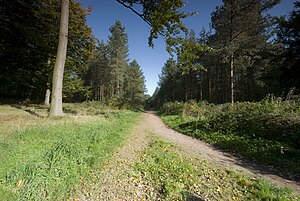Cannock Chase
Cannock ChaseSK000165 is a mixed area of countryside in Staffordshire, between Cannock, Lichfield, Rugeley and Stafford.
The Chase comprises a mixture of natural deciduous woodland, coniferous plantations, open heathland and the remains of early industry, such as coal mining. The landscape owes much to the underlying Triassic bunter formations. Cannock Chase was designated as an "Area of Outstanding Natural Beauty" in 1958 and is the smallest area so designated in mainland Britain, covering 26 square miles. Much of the area is also designated as a "Site of Special Scientific Interest".
Though relatively small in area, the Chase provides a remarkable range of landscape and wildlife, including a herd of around 800 fallow deer and a number of rare and endangered birds, not least migrant nightjars. A feeding station at the Marquis Drive Visitors' Centre, sponsored by the West Midland Bird Club, attracts many species, including bramblings, yellowhammers and bullfinches. Efforts are underway to increase the amount of heathland on the chase, reintroducing shrubs such as heather in some areas where bracken and birch forest have displaced most other plants. The local flora also includes several species of vaccinium, including the eponymous Cannock Chase Berry (vaccinium ×intermedium Ruthe)[1]. In January 2009, an outbreak of Sudden Oak Death disease (Phytophthora ramorum) was discovered on the chase, at Brocton Coppice. Various restrictions were put in place in an attempt to prevent its spread[2].
There are a number of visitor centres, museums and waymarked paths, including the Heart of England Way and the Staffordshire Way. Additionally, there are many unmarked public paths. On the Chase's north-eastern edge can be found Shugborough Hall, ancestral home of the Earls of Lichfield. At its southern edge are the remains of Castle Ring, an Iron Age hill fort, which is the highest point on the Chase. Several glacial erratic boulders are also found on the Chase, remnants of glaciation. One is mounted on a plinth.
The Chase has several war memorials, including Cannock Chase German war cemetery and Commonwealth war cemetery. A memorial to the victims of the Katyn Massacre was unveiled by Stefan Staniszewski, whose father Hillary Zygmunt Staniszewski (a high court judge) died in the massacre. Preserved below the memorial are phials of soil from both Warsaw and the Katyn forest. The mascot Dalmatian dog of the New Zealand Rifle Brigade (Earl of Liverpool's Own) is also buried on the chase marked with a memorial marble headstone.
The Chase is popular with cross-country mountain bike users. The purpose-built XC 'Follow the Dog' trail[3] is a 7 mile, technically challenging route, opened in 2005, starting and finishing at the Birches Valley Visitors/Cycle Centre. It is open to all, however it is not recommended for beginners. A new section of XC trail was opened in April 2010. The 'Monkey Trail' (7 miles) is a more technical trail that splits from 'Follow the Dog' at about the halfway point, then rejoins slightly further on. There are several features mountain bikers can look out for when riding on the chase, such as Kitbag hill, Rabbit hill, Quagmire bridge, Roots hall and Brocton shorts to name just a few.
Since 2006, the forest has been used as an open air music venue as part of the Forestry Commission nationwide "Forest Tour", with well-know performers playing in a forest clearing.
In popular culture
Cannock Chase has developed a number of local legends. Since the nineteenth century, sightings of Black Dogs[4], werewolves[5] and big cats[6] have appeared in the local press, and their more modern variant myth, unidentified flying objects.[7] Such stories have added an aside to a rich local folklore.
References
- ↑ The Flora of Cannock Chase
- ↑ "Sudden Oak Death at Brocton Coppice, Cannock Chase". West Midland Bird Club. 2006-01-06. http://www.westmidlandbirdclub.com/staffordshire/cannockchase/sudden-oak-death. Retrieved 2009-09-23.
- ↑ 'Follow the Dog' trail
- ↑ http://www.chasepost.net/news-in-cannock/cannock-burntwood-news/2009/03/12/hellhound-stalking-cannock-chase-93633-23130526/
- ↑ http://www.bbc.co.uk/stoke/content/articles/2009/09/29/werewolves_in_staffs_feature.shtml
- ↑ http://www.sundaymercury.net/news/midlands-news/2009/08/20/the-beast-of-cannock-chase-is-back-mystery-deepens-66331-24487772/
- ↑ http://forums.sundaymail.co.uk/blogs/cannock_chase_x-files/
Outside links
- Cannock Chase Area of Outstanding Natural Beauty Website
- Staffordshire County Council page on Cannock Chase
- West Midland Bird Club feeding station
- Chase Trails Mountain Biking
- Chase Skills Mountain Bike Coaching at Cannock Chase
- Ramblers' Association page on Cannock Chase
- Article with photo of Katyn memorial at Cannock Chase
- Church Street Conservation Area, Cannock Chase Heritage Trail, cannockchasedc.gov.uk
